| What: | Payroll services consolidation |
| When: | The Bush administration went from 22 to 4 payroll providers starting in 2003. |
| Why it matters: | The e-payroll initiative was one of the most successful examples of federal shared services in the last 20 years. It reduced the cost of processing employee pay and let agencies focus on strategic human capital management rather than processing transactions. |
Politics
The perfect storm drove payroll consolidation to success


There is a little known provision in the Clinger-Cohen Act of 1996 that few federal chief information officers have ever taken advantage of.
But back in January 2003, Mark Forman, the first administrator of e-government and IT — eventually renamed the Federal CIO — at the Office of Management and Budget, knew exactly how to put Section 5113, Performance-based and results-based management, to work.
Forman, one of the architects on the Hill behind the law, worked with OMB Director Mitch Daniels to issue one of the few Clinger-Cohen Act letters. The Bush administration was using this relatively obscure authority to consolidate payroll processing across the government.
“Through you and your agency’s support for this important initiative, agencies have documented good teamwork that resulted in a business case that will yield a better quality and more cost effective approach to government payroll processing. OMB approved the business case for e-Payroll. By consolidating duplicative payroll modernization efforts, the e-Payroll initiative should provide high quality service while saving over $1.2 billion in future IT investment costs from economies of scale and cost avoidance,” Daniels wrote in M-03-05, which was the official Clinger-Cohen letter to initiate the effort.
Over the course of the next several years, OMB, the Office of Personnel Management and agency leaders persuaded, convinced and converted a government of doubters to accomplish what many consider the most successful example of federal shared services by moving from 22 payroll providers to four federal offerings. OMB used the Clinger-Cohen letter to bring together or stop altogether otherwise disparate funding for human resources system modernization efforts.
“It is a very powerful governance and accountability section that is at the heart of treating IT as an investment, using shared services, requiring process improvement before selecting IT and buying IT-as-a-service,” Forman said. “It includes the two-step IT investment reviews, when systems are flailing and at the annual budget process. 5113(b)(5) is particularly relevant to the Clinger Cohen letters such as for ePayroll. It included the authorization for using footnoting and apportioning that we did behind scenes to get alignment in ways that never made it to the press.”
Former federal officials involved in the e-payroll effort credited OMB and OPM’s leadership as well the willingness of the Bush administration to use the law’s authorities to initially force and later shepherd agencies along.
“I think it was two things. One was a decision that OMB and OPM made together, which was where does payroll need to exist? Is it at OPM? Is it at [OMB] from a policy standpoint? How do you make up the difference between managing all of the people and infrastructure and make sure that everybody’s going toward the initiative and are supporting it?” said Jeff Pon, the former deputy director of the E-Gov initiatives at OPM. “The other thing is the willingness of the few to lead this, and I’m talking about people like [former OMB deputy CIO] Tim Young, [former OPM Director] Kay Cole James and [former OPM E-Gov director] Norm Enger as well as all the payroll providers.”
Top down, bottom up approach
Pon, who also served as OPM’s director and as the chief human capital officer at the Energy Department, said the leadership created a structure that fell under the President’s Management Agenda, giving agency leaders a path to get to “green” on the scorecard, but also brought in career budget, IT and human resources leaders to feel a part of the broader effort.
Stephen Galvan, the former OMB E-Gov portfolio manager for the Internal Efficiency and Effectiveness Portfolio, said the White House set up the parameters of the program, starting with letting the agencies choose their payroll provider, with OMB and OPM approval, of course.
But more importantly, the E-Gov program management office created a series of councils that took care of everything from policy to technology to change management challenges to even vendor input.
Kunal Suryavanshi was the lead consultant for OPM’s e-gov initiatives when he worked at IBM in the early 2000s.
Suryavanshi, who is now the growth leader for federal civilian agencies LMI, said the secret sauce to the entire initiative was the Multiagency Executive Strategy Committee (MAESC).
“These 24 agencies came to the table, and we asked them for volunteers of HR experts to participate in these sessions, which were put together by my team in coming up with what they called the Business Reference Model (BRM). The Business Reference Model was the foundation of the ‘to be’ state of the HR function in government,” he said. “That BRM was a seminal document because it was the first time the government had mapped the HR function and the key subfunctions.”
The HR BRM now features 16 functions and 50 sub-functions that represent all the statutorily required activities the government must perform to establish and manage its workforce.
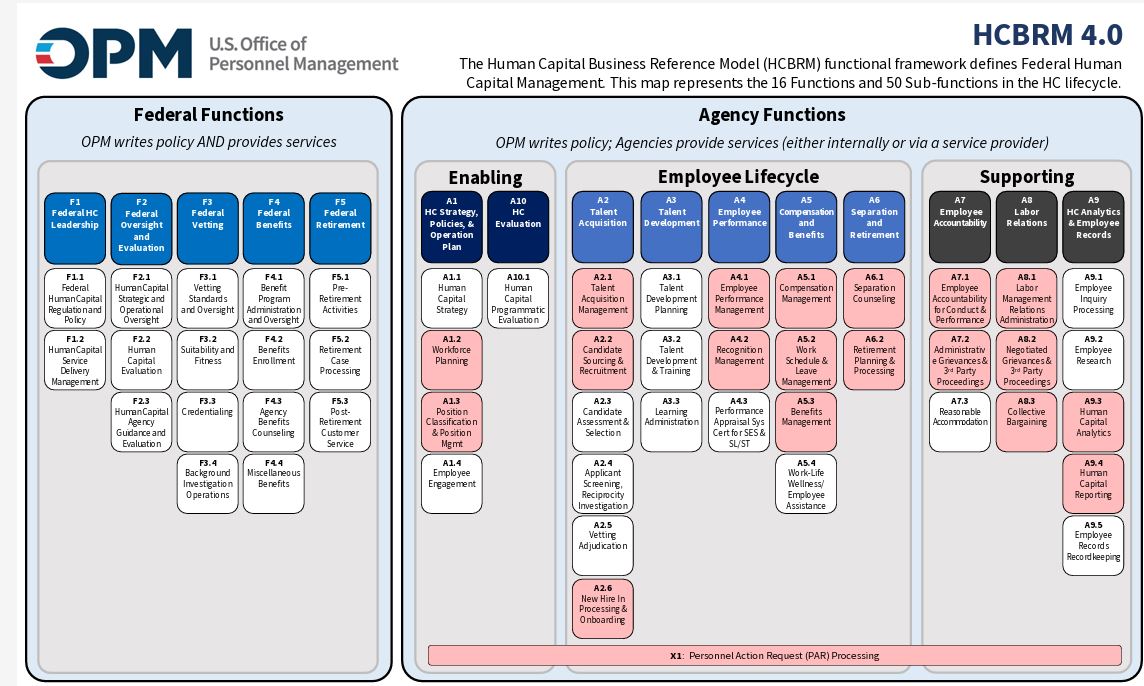 Source: OPM HR LOB website.
Source: OPM HR LOB website.
Suryavanshi said the councils also helped develop other reference models like for service components, technology and a concept of operations.
“We really had to first gain an understanding of how many payroll centers were there. It was stunning that 22 agencies were doing their own payroll operations. That was just mind blowing. Why do you need 22 agencies doing their own payroll and each doing it slightly differently?” he said. “I think it was low hanging fruit that if we can convince agencies to move to a center of excellence type of model, shut down the redundant payroll centers and move to a handful of agencies, which are really good at doing this, it’s going to save the taxpayer a heck of a lot of money and also allow agencies to focus on what is really important, which is the strategic management of human capital, as opposed to doing the transactional bits, which could be done by somebody who does it faster, better and cheaper.”
Pon added OMB and OPM based the whole entire payroll consolidation upon enterprise architecture.
“What business are you in? Payroll. Then the BRM, what services do you provide? We pay people. What performance do you need to have? We need to be on time and pay people. What data do you need to provide so that people get paid? What’s the technology map that supports all these things? So that’s the five enterprise architecture areas. You can actually see that on the line of business which will spread out to the other initiatives. But that’s the basis of our conversation,” he said.
OMB and OPM program team had to convince the agencies that they were not giving up control of their systems and it will not lead to a decline in service quality.
Suryavanshi said the goal was to convince them of the opposite: They will see an uptick in the quality of service and then can redirect funds to better uses, rather than paying for payroll operations and modernizing their payroll systems.
Experts agreed that consolidating payroll providers was no easy task. First off, they said the criticality of getting payroll right helped drive the initiative.
The second challenge was the lack of standardization across the government.
Galvan said there were roughly 192 different pay plans in the government.
“Some pay plans were on different cycles. So one of the benefits of this effort was to standardize. So how are you going to handle it? How are you going to switch over to different pay plans? There was all those kinds of issues which OPM would have worked very closely with the different organizations, with the different agencies there,” he said.
Galvan credited the 2002 Joint Financial Management Improvement Program (JFMIP) white paper that analyzed federal payroll processing and systems as underlying data and structure to this effort. He said this analysis became the basis for the business case and rationale to consolidate the 22 payroll systems.
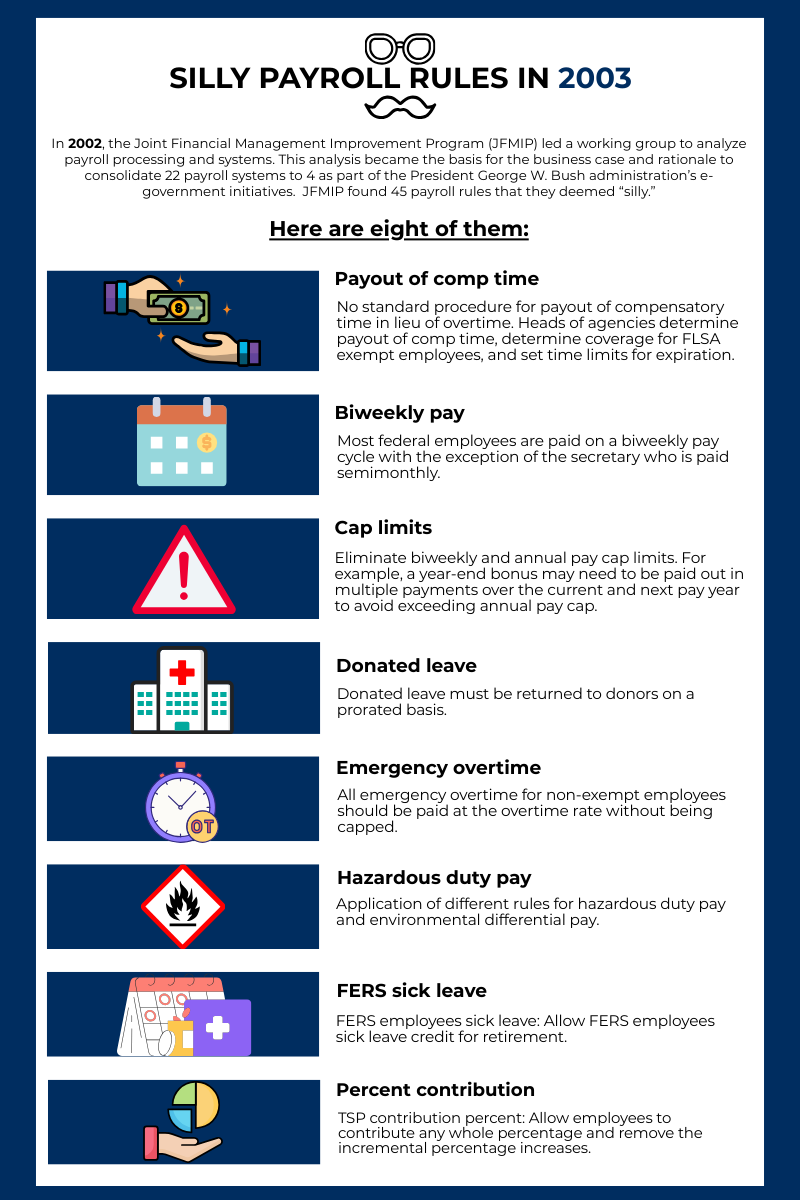 Graphic by: Derace Lauderdale
Graphic by: Derace Lauderdale
The benefits of the consolidation were clear from the beginning and the data is why back-office consolidation is a priority of the Trump administration.
Galvan said before the payroll consolidation, the government’s average cost to process a single employee’s payroll was $77. That cost per employee came way down and the Government Accountability Office estimated in 2009 that the government saved or avoided spending $1.3 billion because of this initiative.
The ultimate success of the payroll consolidation effort led Pon to a memorable moment.
“We gave [GAO] the presentation, and it was probably one of the best moments of my government career because at the end, they stood up and started clapping. GAO started clapping. I’ve never seen GAO clap for anybody, let alone have a standing ovation for a presentation on payroll,” he said. “You hear payroll, it’s not very sexy. But it was one of the best run initiatives across government and it made a huge impact in the federal government, literally billions of dollars of savings.”
The experts agreed that the move to consolidate other back office functions lost momentum in the waning years of the Bush administration and never picked up the kind of steam that e-payroll did.
Galvan said e-payroll took time, effort and leadership, and without each of these three legs, the stool would’ve fallen.
“We’ve seen DOGE and there’s a lot of cost identification and cost reductions and all that, but you’re going into this next phase now: We have got to achieve delivery performance. How are we going to measure performance? How are we going to manage the contracts to address performance? It’s going to still take data. It’s going to take a real detail as to where you want to be and how you’re going to get there,” he said. “You’re just not going to say, ‘I’m going to drop this new technology because it’s there and it allows me to do a number of things.’ You still have to migrate that over. You’ve got to train your workforce. You have to justify it to OMB, to Congress, and you’ve got to really deal with the performance outcomes for where the agencies are going. That takes a lot of lot of time and effort, and then you’ve got to do your operations.”
During the first Trump administration, OMB and the General Services Administration led an effort through the Technology Modernization Fund to further modernize payroll processing, called New Pay. In September 2018, the TMF board made awards to two teams of vendors who received $20.7 million to begin working on further consolidation and move systems to the cloud. GSA never could get the program out of the initial prototype and testing stages.
“Given uncertain timing of agency migrations to the new tool and lack of appropriations for planning and migration activities in fiscal 2019 and 2020, GSA reduced the scope and funding required for their TMF investment,” the TMF website states.
The TMF Board ended the project in July 2021 after investing $7.3 million.
Suryavanshi, the former IBM contractor, said OMB should bring back the idea of a managing partner to lead these future consolidation efforts.
“When the managing partner authority changed or got redirected or got watered down, you could see that agencies started investing in shadow back office operations, and the momentum was lost. I think that maintaining that managing partner model, which was subsequently renamed as Quality Service Management Office (QSMO), made it too complicated,” he said. “A managing partner was very clear. It was very clear vocabulary that a certain agency is the managing partner. Treasury was the managing partner for financial management. OPM was a managing partner for human resources. These were the agencies that would drive the consolidation and standardization and common solutions in those functions. I think the momentum was lost and I think it’s a pity because they did realize about $1.3 billion in cost savings, but they could have easily gone even further and driven even more cost out of this function.”
Suryavanshi said he would like to see OMB “dust off” the e-government playbook for shared services and with the technology advancements like generative artificial intelligence, the government has a much bigger opportunity to consolidate and drive savings.
The post The perfect storm drove payroll consolidation to success first appeared on Federal News Network.
Politics
President Trump Taps Dr. Ben Carson for New Role — A HUGE Win for America First Agenda
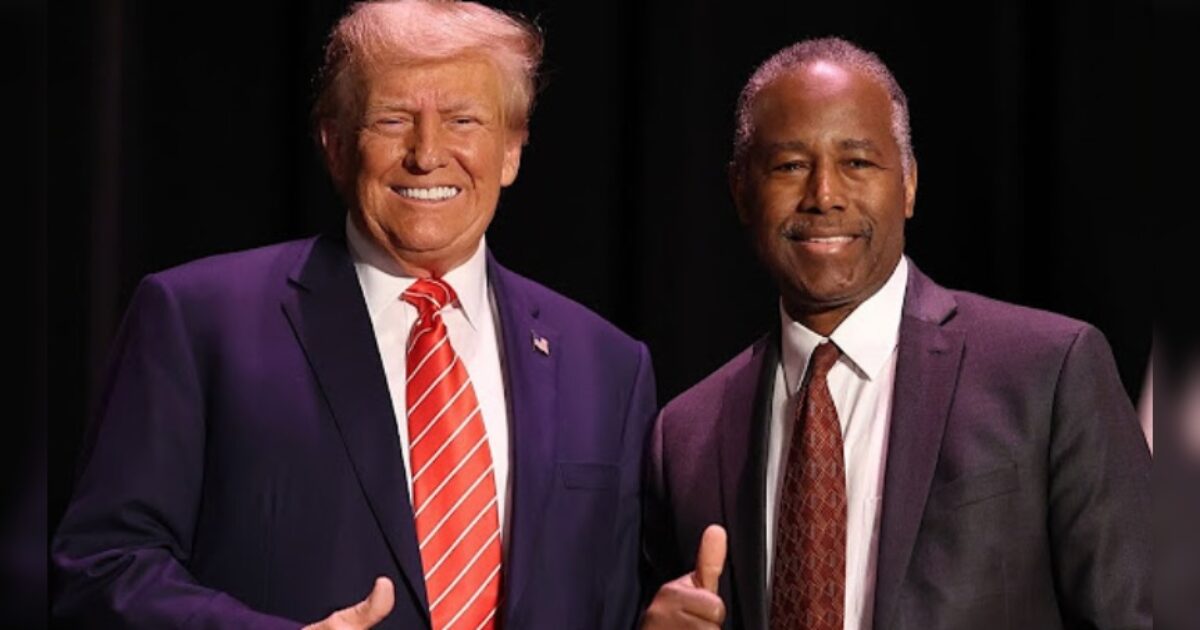
Dr. Ben Carson is the newest member of the Trump administration.
On Wednesday, former Secretary of the Department of Housing and Urban Development, Ben Carson, was sworn in as the national adviser for nutrition, health, and housing at the U.S. Department of Agriculture.
Agriculture Secretary Brooke Rollins shared that Carson’s role will be to oversee Trump’s new Big Beautiful Bill law, which aims to ensure Americans’ quality of life, from nutrition to stable housing.
After being sworn in, Carson shared, “Today, too many Americans are suffering from the effects of poor nutrition. Through common-sense policymaking, we have an opportunity to give our most vulnerable families the tools they need to flourish.”
WATCH:
BREAKING Dr. Ben Carson has been sworn in as the National Nutrition Advisor to Make America Healthy Again
THIS IS A HUGE WIN pic.twitter.com/Dr5AsSDkRM
— MAGA Voice (@MAGAVoice) September 24, 2025
Per USDA:
Today, U.S. Secretary of Agriculture Brooke L. Rollins announced that Dr. Benjamin S. Carson, Sr., M.D., was sworn in as the National Advisor for Nutrition, Health, and Housing at the U.S. Department of Agriculture (USDA).
“There is no one more qualified than Dr. Carson to advise on policies that improve Americans’ everyday quality of life, from nutrition to healthcare quality to ensuring families have access to safe and stable housing,” said Secretary Rollins.
“With six in ten Americans living with at least one chronic disease, and rural communities facing unique challenges with respect to adequate housing, Dr. Carson’s insight and experience is critical. Dr. Carson will be crucial to implementing the rural health investment provisions of the One Big Beautiful Bill and advise on America First polices related to nutrition, health, and housing.
“As the U.S. Secretary of Housing and Urban Development in the first Trump Administration, Dr. Carson worked to expand opportunity and strengthen communities, and we are honored to welcome him to the second Trump Administration to help lead our efforts here at USDA to Make America Healthy Again and ensure rural America continues to prosper.”
“Today, too many Americans are suffering from the effects of poor nutrition. Through common-sense policymaking, we have an opportunity to give our most vulnerable families the tools they need to flourish,” said Dr. Ben Carson. “I am honored to work with Secretary Rollins on these important initiatives to help fulfill President Trump’s vision for a healthier, stronger America.”
On Sunday, Dr. Carson was one of the many speakers at the memorial service of the late TPUSA founder Charlie Kirk.
During the memorial service, Carson highlighted that Kirk was shot at 12:24 p.m. and then continued to share the Bible verse John 12:24, which reads, “Verily, verily, I say unto you, Except a corn of wheat fall into the ground and die, it abideth alone: but if it die, it bringeth forth much fruit.”
WATCH:
Ben Carson reads John 12:24 at the Charlie Kirk’s funeral. Charlie was shot at 12:24.
It reads: “Very truly I tell you, unless a kernel of wheat falls to the ground and dies, it remains only a single seed. But if it dies, it produces many seeds”
God is moving and speaking. pic.twitter.com/0ZbVTAwwYl
— Danny Botta (@danny_botta) September 21, 2025
The post President Trump Taps Dr. Ben Carson for New Role — A HUGE Win for America First Agenda appeared first on The Gateway Pundit.
Politics
LEAKED MEMO: Deep State Prosecutors in the Eastern District of Virginia Claim There Isn’t Enough Evidence to Convict Comey Amid Reports of Imminent Indictment
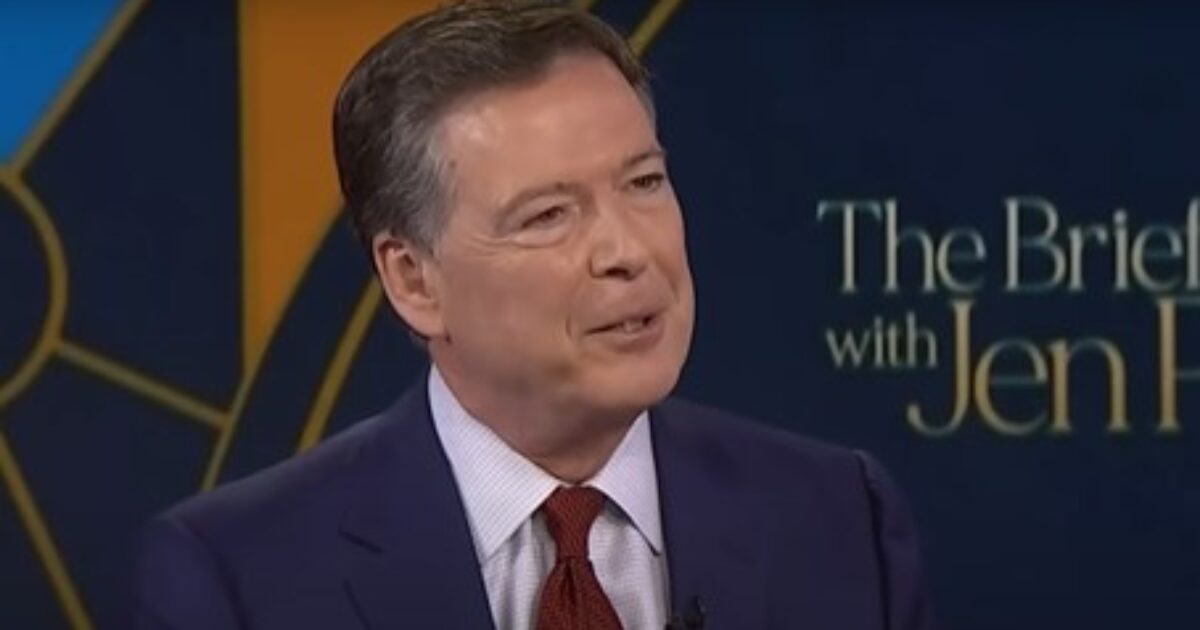
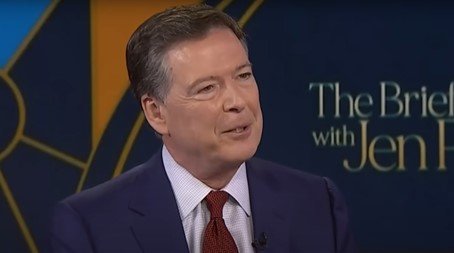
On Wednesday evening, disgruntled officials in the Eastern District of Virginia leaked contents of a memo explaining why charges should not be brought against James Comey.
As reported earlier, former FBI Director James Comey is expected to be indicted in the Eastern District of Virginia in the next few days.
Comey will reportedly be charged for lying to Congress in a 2020 testimony about whether he authorized leaks to the media.
Officials in the Eastern District of Virginia are still fighting to stop Comey from being charged after Trump fired US Attorney Erik Siebert.
President Trump last week fired Erik Siebert as the US Attorney for the Eastern District of Virginia because he refused to bring charges against Letitia James, Comey, Schiff and others.
On Saturday evening, President Trump announced that he had appointed Lindsey Halligan – his personal attorney who defended him against the Mar-a-Lago raid – as US Attorney for the Eastern District of Virginia.
Now, with just days to go before the statute of limitations runs out to charge Comey for lying during a September 30, 2020 testimony, Lindsey Halligan is reportedly gearing up to indict Comey.
Prosecutors reportedly gave newly sworn-in Halligan a memo defending James Comey and explaining why charges should not brought against the fired FBI Director.
Per MSNBC’s Ken Dilanian:
Two sources familiar with the matter tell me prosecutors in the EDVA US attorney‘s office presented newly sworn US attorney Lindsey Halligan with a memo explaining why charges should not be brought against James Comey, because there isn’t enough evidence to establish probable cause a crime was committed, let alone enough to convince a jury to convict him.
Justice Department guidelines say a case should not be brought unless prosecutors believe it’s more likely than not that they can win a conviction beyond a reasonable doubt.
Two sources familiar with the matter tell me prosecutors in the EDVA US attorney‘s office presented newly sworn US attorney Lindsey Halligan with a memo explaining why charges should not be brought against James Comey, because there isn’t enough evidence to establish probable…
— Ken Dilanian (@DilanianMSNBC) September 24, 2025
The post LEAKED MEMO: Deep State Prosecutors in the Eastern District of Virginia Claim There Isn’t Enough Evidence to Convict Comey Amid Reports of Imminent Indictment appeared first on The Gateway Pundit.
Politics
Nearly 8 in 10 Voters Say the United States is in Political Crisis After the Assassination of Charlie Kirk

Nearly eight in ten voters believe that the United States is in a political crisis in the wake of the assassination of conservative icon Charlie Kirk.
According to a Quinnipiac University national poll of registered voters released on Wednesday, a massive 93 percent of Democrats, 84 percent of independents, and 60 percent of Republicans said the nation is in a political crisis.
“The Kirk assassination lays bare raw, bipartisan concerns about where the country is headed,” Quinnipiac University Polling Analyst Tim Malloy said of the poll results.
Quinnipiac reports:
Seventy-one percent of voters think politically motivated violence in the United States today is a very serious problem, 22 percent think it is a somewhat serious problem, 3 percent think it is a not so serious problem, and 1 percent think it is not a problem at all.
This is a jump from Quinnipiac University’s June 26 poll when 54 percent thought politically motivated violence in the United States today was a very serious problem, 37 percent thought it was a somewhat serious problem, 6 percent thought it was a not so serious problem, and 2 percent thought it was not a problem at all.
Nearly 6 in 10 voters (58 percent) think it will not be possible to lower the temperature on political rhetoric and speech in the United States, while 34 percent think it will be possible.
Over half, 54 percent, of voters believe the US will see increased political violence over the next few years. Another 27 percent said they think it will stay “about the same,” while just 14 percent believe it will ease.
A 53 percent majority also said they are “pessimistic about freedom of speech being protected in the United States.”
Surprisingly, a 53 percent majority also believes the current system of democracy is not working.
“From a perceived assault on freedom of speech to the fragility of the democracy, a shudder of concern and pessimism rattles a broad swath of the electorate. Nearly 80 percent of registered voters feel they are witnessing a political crisis, seven in ten say political violence is a very serious problem, and a majority say this discord won’t go away anytime soon,” Malloy added.
The vast majority, 82 percent, said the way that people discuss politics is contributing to the violence.
“When asked if political discourse is contributing to violence, a rare meeting of the minds…Republicans, Democrats, and independents in equal numbers say yes, it is,” Malloy said.
The survey was conducted from September 18 to 21 among 1,276 registered voters with a margin of error of +/- 3.3 percentage points.
The post Nearly 8 in 10 Voters Say the United States is in Political Crisis After the Assassination of Charlie Kirk appeared first on The Gateway Pundit.
-

 Entertainment6 months ago
Entertainment6 months agoNew Kid and Family Movies in 2025: Calendar of Release Dates (Updating)
-

 Entertainment3 months ago
Entertainment3 months agoBrooklyn Mirage Has Been Quietly Co-Managed by Hedge Fund Manager Axar Capital Amid Reopening Drama
-
Tech6 months ago
The best sexting apps in 2025
-

 Entertainment5 months ago
Entertainment5 months agoKid and Family TV Shows in 2025: New Series & Season Premiere Dates (Updating)
-

 Tech7 months ago
Tech7 months agoEvery potential TikTok buyer we know about
-
Tech7 months ago
iOS 18.4 developer beta released — heres what you can expect
-

 Tech7 months ago
Tech7 months agoAre You an RSSMasher?
-

 Politics7 months ago
Politics7 months agoDOGE-ing toward the best Department of Defense ever





